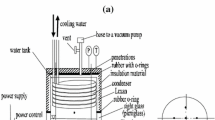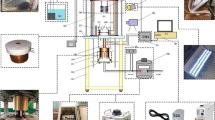Abstract
Coupling the nanofluid as working fluid and the copper beads packed porous structure on heating surface were employed to enhance the pool boiling heat transfer by changing the fluid properties with the adjunction of nanoparticles in liquid and altering the heating surface with a bead porous layer. Due to the higher thermal conductivity, the copper beads served as an extended heating surface and the boiling nucleation sites rose, but the flow resistance increased. The CuO–water and SiO2–water nanofluids as well as the pure water were respectively employed as working fluids in the pool boiling experiments. Comparing with the base fluid of water, the higher thermal conductivity and lower surface tension occur in the nanofluids and those favor the boiling heat transfer, but the higher viscosity and density of nanofluids serve as deteriorative factors. So, the concentration region of the nanofluids should be chosen properly. The maximum relative error between the collected experimental data of the pure water on a flat surface and the theoretical prediction of pool boiling using the Rohsenow correlation was less than 12 %. The comparisons of the pool boiling heat transfer characteristics were also conducted between the pure water and the nanofluids respectively on the horizontal flat surface and on the heating surface packed with a copper bead porous layer. Besides, the boiling bubble generation, integration and departure have a great affect on the pool boiling and were recorded with a camera in the bead stacked porous structures at different heat flux.








Similar content being viewed by others
Abbreviations
- c pl :
-
Specific heat of liquid water (J kg−1 K−1)
- C sf :
-
Constant in Rohsenow correlation (equal to 0.53), see Eq. (3) and Ref. [12]
- g :
-
Gravitational acceleration vector (m s−2)
- h fg :
-
Latent heat of water (J kg−1)
- Pr:
-
Prandtl number of liquid water
- q :
-
Heat flux on heating surface (W m−2 or W cm−2)
- r :
-
Constant in Rohsenow correlation (equal to 1), see Eq. (3) and Ref. [12]
- s :
-
Constant in Rohsenow correlation (equal to 0.66),see Eq. (3) and Ref. [12]
- T w :
-
Heating surface temperature inside the boiling vessel, K
- T sat :
-
Saturated temperature of liquid water (K)
- ΔT :
-
Heating surface superheat (K)
- σ :
-
Surface tension of liquid water (N m−1)
- ρ l :
-
Density of liquid water (kg m−3)
- ρ v :
-
Density of water vapor (kg m−3)
- μ :
-
Dynamic viscosity of liquid water (kg (m s)−1)
- δ 1 :
-
Vertical distance between the upper thermocouple and the lower (m)
- δ 2 :
-
Vertical distance between the upper thermocouple and the heating surface (m)
- i :
-
Number of thermocouples; i = 1–4 refers to the number of the thermocouples at 0.8 mm beneath the heating surface; i = 5–8 refers to the number of the thermocouples at 4.5 mm beneath the heating surface
References
Ali AF, El-GenK MS (2012) Spreaders for immersion nucleate boiling cooling of a computer chip with a central hot spot. Energy Convers Manag 53(1):259–267
Chein R, Huang G (2004) Thermoelectric cooler application in electronic cooling. Appl Therm Eng 24(14–15):286–289
JanicKi M, Napieralski A (2000) Modeling electronic circuit radiation cooling using analytical thermal model. Microelectron J 31(9–10):781–785
Wang CY, Cheng P (1997) Multiphase flow and heat transfer in porous media. Adv Heat Transf 30:93–196
Cheng P, Zhao TS (1998) Heat transfer in oscillatory flows. Ann Rev Heat Transf IX:359–420
Faghri A (1995) Heat pipe science and technology. Global Digital Press, Columbia
Li C, Peterson GP, Wang Y (2006) Evaporation/boiling in thin capillary wicks (l)-wick thickness effects. J Heat Transf 128(12):1312–1319
Li C, Peterson GP (2006) Evaporation/boiling in thin capillary wicks (II): effects of volumetric porosity and mesh size. J Heat Transf 128(12):1320–1328
Hwang GS, Kaviany M (2006) Critical heat flux in thin uniform particle coatings. Int J Heat Mass Transf 49(5):844–849
Liter SG, Kaviany M (2001) Pool-boiling CHF enhancement by modulated porous-layer coating: theory and experiment. Int J Heat Mass Transf 44(22):4287–4311
Wang Z, Peng XF, Ochterbeck JM (2004) Dynamic bubble behavior during boiling in bead-packed structures. Int J Heat Mass Transf 47:4771–4783
Li CH, Li T, Hodgins P, Peterson GP (2011) Characteristics of pool boiling bubble dynamics in bead packed porous structures. J Heat Transf 133(3):0310041–03100410
Sarangi S, Weibel JA, Garimella SV (2015) Effect of particle size on surface-coating enhancement of pool boiling heat transfer. Int J Heat Mass Transf 81(2):103–113
Hong FJ, Cheng P, Wu HY, Sun Z (2013) Evaporation/boiling heat transfer on capillary feed copper particle sintered porous wick at reduced pressure. Int J Heat Mass Transf 63(8):389–400
Lee S, Choi SUS, Li S, Eastman JA (1999) Measuring thermal conductivity of fluids containing oxide nanoparticles. ASME J Heat Transf 121:280–289
Das SK, Putra N, Roetzel W (2003) Pool boiling characteristics of nano-fluids. Int J Heat Mass Transf 46:851–862
Bang IC, Chang SH (2005) Boiling heat transfer performance and phenomena of Al2O3–water nano-fluids from a flat surface in a pool. Int J Heat Mass Transf 48:2407–2419
Kim H, Kim J, Kim MH (2006) Effect of nanoparticles on CHF enhancement in pool boiling of nano-fluids. Int J Heat Mass Transf 49:5070–5074
Kim TI, Jeong YH, Chang SH (2010) An experimental study on CHF enhancement in flow boiling using Al2O3 nano-fluid. Int J Heat Mass Transf 53:1015–1022
Ahmed O, Hamed MS (2012) Experimental investigation of the effect of particle deposition on pool boiling of nanofluids. Int J Heat Mass Transf 55:3423–3436
Ganapathy H, Sajith V (2013) Semi-analytical model for pool boiling of nanofluids. Int J Heat Mass Transf 57:32–47
Peng H, Ding G, Haitao H, Jiang W, Zhuang D (2010) Nucleate pool boiling heat transfer characteristics of refrigerant/oil mixture with diamond nanoparticles. Int J Refrig 33:347–358
Rohsenow WM (1952) A method of correlating heat transfer data for surface boiling of liquids. J Heat Transf 74:969–975
Acknowledgments
The current work is financially supported by the National Natural Science Foundation of China. (No. 51276107), the Innovation Program of Shanghai Municipal Education Commission (14ZZ142) and the Ministry of Transport Application Foundation Project (2013319810150).
Author information
Authors and Affiliations
Corresponding author
Rights and permissions
About this article
Cite this article
Chen, W., Wang, J. Experimental analysis of nanofluid pool boiling heat transfer in copper bead packed porous layers. Heat Mass Transfer 53, 877–885 (2017). https://doi.org/10.1007/s00231-016-1854-x
Received:
Accepted:
Published:
Issue Date:
DOI: https://doi.org/10.1007/s00231-016-1854-x




